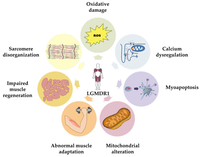Limb-Girdle Muscular Dystrophy Type 2a

Limb-girdle muscular dystrophy type 2A (LGMD2A) is an autosomal recessive limb-girdle muscular dystrophy characterized by progressive, symmetrical weakness of the proximal limb and girdle muscles (mainly those around the hips and shoulders) without heart involvement or intellectual disability. The condition is caused by mutations in the CAPN3 gene. Type 2A is the most common form of limb-girdle muscular dystrophy, accounting for about 30 percent of cases. Treatment is aimed at maintaining mobility and preventing complications.
LGMD2A is also known as primary calpainopathy. Calpainopathies are diseases caused by mutations in the CAPN3 gene and can be autosomal recessive or autosomal dominant.
There are three subtypes of autosomal recessive disorders associated with mutations in the CAPN3 gene which differ by the distribution of muscle weakness and age at onset:
LGMD2A is also known as primary calpainopathy. Calpainopathies are diseases caused by mutations in the CAPN3 gene and can be autosomal recessive or autosomal dominant.
There are three subtypes of autosomal recessive disorders associated with mutations in the CAPN3 gene which differ by the distribution of muscle weakness and age at onset:
- Pelvifemoral limb-girdle muscular dystrophy (also known as Leyden-Mobius LGMD) is the most frequently observed subtype. In these cases, muscle weakness is first evident in the pelvic girdle and later in the shoulder girdle. Onset is usually before age 12 or after age 30;
- Scapulohumeral LGMD (also known as Erb LGMD) usually has milder symptoms with infrequent early onset. In most cases, muscle weakness is first evident in the shoulder girdle and later in the pelvic girdle;
- HyperCKemia is usually observed in children or young individuals. In most cases, those affected do not have symptoms, just high levels of creatine kinase in their blood.